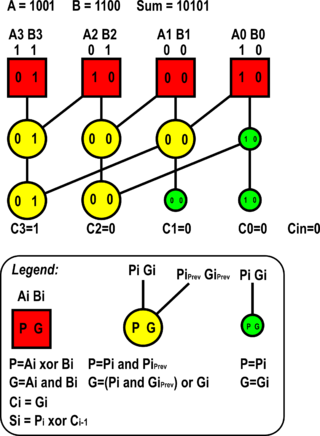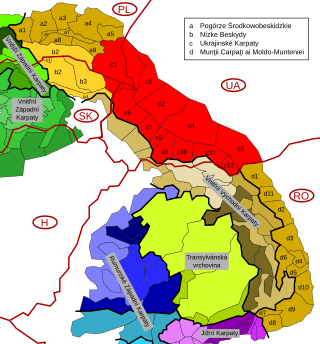Related Research Articles
In mathematics and computer science, Horner's method is an algorithm for polynomial evaluation. Although named after William George Horner, this method is much older, as it has been attributed to Joseph-Louis Lagrange by Horner himself, and can be traced back many hundreds of years to Chinese and Persian mathematicians. After the introduction of computers, this algorithm became fundamental for computing efficiently with polynomials.

In numerical analysis, the Newton–Raphson method, also known simply as Newton's method, named after Isaac Newton and Joseph Raphson, is a root-finding algorithm which produces successively better approximations to the roots of a real-valued function. The most basic version starts with a real-valued function f, its derivative f′, and an initial guess x0 for a root of f. If f satisfies certain assumptions and the initial guess is close, then
In mathematics, a polynomial is a mathematical expression consisting of indeterminates and coefficients, that involves only the operations of addition, subtraction, multiplication and exponentiation to nonnegative integer powers, and has a finite number of terms. An example of a polynomial of a single indeterminate x is x2 − 4x + 7. An example with three indeterminates is x3 + 2xyz2 − yz + 1.
In information theory and coding theory, Reed–Solomon codes are a group of error-correcting codes that were introduced by Irving S. Reed and Gustave Solomon in 1960. They have many applications, including consumer technologies such as MiniDiscs, CDs, DVDs, Blu-ray discs, QR codes, Data Matrix, data transmission technologies such as DSL and WiMAX, broadcast systems such as satellite communications, DVB and ATSC, and storage systems such as RAID 6.
In numerical analysis, a root-finding algorithm is an algorithm for finding zeros, also called "roots", of continuous functions. A zero of a function f is a number x such that f(x) = 0. As, generally, the zeros of a function cannot be computed exactly nor expressed in closed form, root-finding algorithms provide approximations to zeros. For functions from the real numbers to real numbers or from the complex numbers to the complex numbers, these are expressed either as floating-point numbers without error bounds or as floating-point values together with error bounds. The latter, approximations with error bounds, are equivalent to small isolating intervals for real roots or disks for complex roots.
The city of Buenos Aires is formally divided in 48 barrios (neighborhoods), grouped into 15 comunas (communes), which are defined as "units of decentralized political and administrative management governed by designated residents".

The British C-class submarines were the last class of petrol engined submarines of the Royal Navy and marked the end of the development of the Holland class in the Royal Navy. Thirty-eight were constructed between 1905 and 1910 and they served through World War I.

In computing, the Kogge–Stone adder is a parallel prefix form of carry-lookahead adder. Other parallel prefix adders (PPA) include the Sklansky adder (SA), Brent–Kung adder (BKA), the Han–Carlson adder (HCA), the fastest known variation, the Lynch–Swartzlander spanning tree adder (STA), Knowles adder (KNA) and Beaumont-Smith adder (BSA).
In algebra, the greatest common divisor of two polynomials is a polynomial, of the highest possible degree, that is a factor of both the two original polynomials. This concept is analogous to the greatest common divisor of two integers.
A system of polynomial equations is a set of simultaneous equations f1 = 0, ..., fh = 0 where the fi are polynomials in several variables, say x1, ..., xn, over some field k.
In mathematics, the Conway polynomialCp,n for the finite field Fpn is a particular irreducible polynomial of degree n over Fp that can be used to define a standard representation of Fpn as a splitting field of Cp,n. Conway polynomials were named after John H. Conway by Richard A. Parker, who was the first to define them and compute examples. Conway polynomials satisfy a certain compatibility condition that had been proposed by Conway between the representation of a field and the representations of its subfields. They are important in computer algebra where they provide portability among different mathematical databases and computer algebra systems. Since Conway polynomials are expensive to compute, they must be stored to be used in practice. Databases of Conway polynomials are available in the computer algebra systems GAP, Macaulay2, Magma, SageMath, at the web site of Frank Lübeck, and at the Online Encyclopedia of Integer Sequences.

In mathematics, an affine root system is a root system of affine-linear functions on a Euclidean space. They are used in the classification of affine Lie algebras and superalgebras, and semisimple p-adic algebraic groups, and correspond to families of Macdonald polynomials. The reduced affine root systems were used by Kac and Moody in their work on Kac–Moody algebras. Possibly non-reduced affine root systems were introduced and classified by Macdonald (1972) and Bruhat & Tits (1972).

Television's Greatest Hits: Black & White Classics, prefaced with "TeeVee Toons Presents", is a 1996 compilation album of television theme songs from the 1950s and 1960s released by TVT Records as the fourth volume of the Television's Greatest Hits series.

Television's Greatest Hits: In Living Color, prefaced with "TeeVee Toons Presents", is a 1996 compilation album of 65 television theme songs from the 1960s and 1970s released by TVT Records as the fifth volume of the Television's Greatest Hits series.

Television's Greatest Hits: Remote Control, prefaced with "TeeVee Toons Presents", is a 1996 compilation album of 65 television theme songs from the 1970s and 1980s released by TVT Records as the sixth volume of the Television's Greatest Hits series.

Television's Greatest Hits: Cable Ready, prefaced with "TeeVee Toons Presents", is a 1996 compilation album of television theme songs from the 1980s and early 1990s released by TVT Records as the seventh volume of the Television's Greatest Hits series.

Following international norms, road signs in Nepal are controlled by the Nepali Department of Roads and are heavily influenced by those used in the United Kingdom.
Indian Railways operates India's railway system and comes under the purview of the Ministry of Railways of Government of India. Indian Railways operates more than 4000 cargo and goods trains daily. It hauls variety of cargo to cater to various requirements and have specialized rolling stock corresponding to the cargo hauled. Indian Railways uses a specific wagon numbering system, adopted in 2003.

The Eastern Beskids or Eastern Beskyds are a geological group of mountain ranges of the Beskids, within the Outer Eastern Carpathians. As a continuation of the Central Beskids, this mountain range includes the far southeastern corner of Poland, the far eastern corner of Slovakia, and stretches southward through western parts of Ukraine, up to the border of Romania.
References
- Estrin, Gerald (May 1960). "Organization of computer systems: The fixed plus variable structure computer" (PDF). Papers presented at the May 3-5, 1960, western joint IRE-AIEE-ACM computer conference on - IRE-AIEE-ACM '60 (Western). San Francisco. pp. 33–40. doi:10.1145/1460361.1460365. ISBN 978-1-4503-7869-7. S2CID 16384320.
{{cite book}}: CS1 maint: location missing publisher (link) - Muller, Jean-Michel (2005). Elementary Functions: Algorithms and Implementation (2nd ed.). Birkhäuser. p. 58. ISBN 0-8176-4372-9.